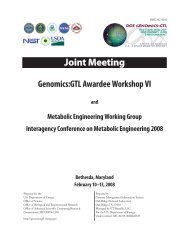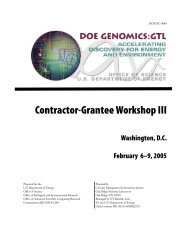Joint Meeting - Genomics - U.S. Department of Energy
Joint Meeting - Genomics - U.S. Department of Energy
Joint Meeting - Genomics - U.S. Department of Energy
Create successful ePaper yourself
Turn your PDF publications into a flip-book with our unique Google optimized e-Paper software.
Milestone 1<br />
2 High Throughput Genome Annotation for U.S. DOE <strong>Joint</strong> Genome<br />
Institute Microbial Genomes<br />
Miriam Land* (landml@ornl.gov), Loren Hauser, Phil LoCascio, Gwo-Liang Chen, Denise<br />
Schmoyer, and Frank Larimer<br />
Oak Ridge National Laboratory, Oak Ridge TN<br />
http://genome.ornl.gov/microbial/<br />
The U.S. DOE <strong>Joint</strong> Genome Institute ( JGI) performs high-throughput sequencing and annotation<br />
<strong>of</strong> microbial genomes through the DOE Microbial Genome Program (MGP). The world-wide<br />
rate <strong>of</strong> sequencing is resulting in a rapid expansion <strong>of</strong> microbial genomic data, which requires the<br />
development <strong>of</strong> comprehensive automated tools to provide in-depth annotation which can keep<br />
pace with the expanding microbial dataset. We have and continue to develop tools for genome<br />
analysis that provide automated, regularly updated, comprehensive annotation <strong>of</strong> microbial genomes<br />
using consistent methodology for gene calling and feature recognition. We have developed and continue<br />
to improve a genome annotation pipeline. The pipeline includes gene calls, multiple database<br />
searches, prediction <strong>of</strong> RNAs, and other annotation tools as they become available for a diverse and<br />
automated annotation.<br />
Comprehensive representation <strong>of</strong> microbial genomes requires deeper annotation <strong>of</strong> structural features,<br />
including operon and regulon organization, promoter and ribosome binding site recognition,<br />
miscellaneous RNAs, and other functional elements. Linkage and integration <strong>of</strong> the gene/protein/<br />
function catalog to phylogenomic, structural, proteomic, transcriptional, and metabolic pr<strong>of</strong>iles<br />
are being developed. The expanding set <strong>of</strong> microbial genomes comprises an extensive resource for<br />
comparative genomes: new tools continue to be developed for rapid exploration <strong>of</strong> gene and operon<br />
phylogeny, regulatory networking, and functional proteomics.<br />
A major continuing activity involves the public release <strong>of</strong> the data. Each genome is supported with<br />
a web site <strong>of</strong> the automated annotation, the data are submitted to GenBank for broader release<br />
and the data are prepared for the JGI’s Integrated Microbial Genomes (IMG) database. The IMG<br />
resource is updated quarterly, in addition to the continuous addition <strong>of</strong> new genomes from JGI.<br />
50-100 new projects will be initiated annually by JGI that require annotation. The deep sequencing<br />
<strong>of</strong> specific genera as well as specialized (physiological and phylogenetic) groups requires new views<br />
and analytical schemes.<br />
The JGI is made up <strong>of</strong> affiliates from a number <strong>of</strong> national laboratories including Lawrence Berkeley<br />
National Laboratory, Lawrence Livermore National Laboratory, Los Alamos National Laboratory,<br />
Oak Ridge National Laboratory, and the Stanford Human Genome Center.<br />
4 * Presenting author





